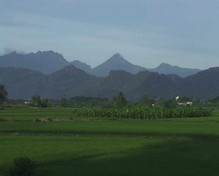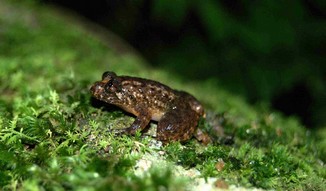Agasthya
A newsletter on the Natural History, Ecology
and Conservation of the Agasthyamalai region, Western Ghats, India.
ASHOKA TRUST FOR RESEARCH IN ECOLOGY AND THE ENVIRONMENT
Centre for Excellence in Conservation Science
Royal Enclave,Srirampura,Jakkur Post
Bangalore-560064
Telephone: 080-23635555 (EPABX)
Fax : 080- 23530070
Any and all opinions expressed in this newsletter are solely those of the author(s) and do not reflect the opinion of ATREE.
Editorial Team
Editor: T. Ganesh
Associate editor: Vivek Ramachandran
Editorial Review: R. Ganesan, M. Soubadra Devy
Design and presentation: Vivek Ramachandran
A S H O K A T R U S T F O R R E S E A R C H I N E C O L O G Y A N D T H E E N V I R O N M E N T
Four Frogging Days in Kodayar- One Enormous Lifer!
-Kaushalika Dharmadhikari and Chetana B Purushotham
"Oh look! There's one…. there on that mossy rock….Micrixalus…..ummm….saxicola?",
"Yes it is!"…"Hey, Nycti under those leaves"… "Sorry, missed it!"
Yes, this is how we spent most of our time while conducting a project on Hill Stream
Anurans (frogs & toads) . We covered two streams - one in the primary evergreen forest and one in the trimmed tea plantations of Nalmukh.
The very tiny, yet rich microhabitats such as small mossy rocks, fern islands in streams, dead leaf litter packs congregated at the water edge, fallen logs, an overhanging rock, and crevices form important niches for amphibians. While it is known that large mammals such as tigers, elephants, ungulates need large areas to thrive; smaller creatures such as amphibians, reptiles also have preferred habitats. In simple words, they too may be 'choosy' with their space! This being the case, it is important to understand the importance of these niches as they occur in the wider angle of an ecosystem of any forest or plantation. 112 individuals of 4 genera Micrixalus, Nytcibatracus, Hyalarana, Indirana, were recorded from the forest stream while only 48 of two genera Hylarana, Duttaphrynus were recorded from the tea plantation stream. Only one of the 7 species, Hylarana temporalis was found to be common to both the habitat sites. One of the reasons could be that substrate availability showed a significant difference between the sites . Also, in the stream within the tea plantation, diversity a well as abundance increased as the distance from potential sources of pollution increased.
Besides being marveled at getting a chance to work on frogs in streams, it was simply splendid to explore the forests in KMTR; to rise up at before dawn along with the sun's first rays; to touch the cool waters in the stream; to share the days experiences with the other two groups and to 'chill' at Rajan's tea shop over endless cups of steaming black coffee and Sambar-Rice!!








